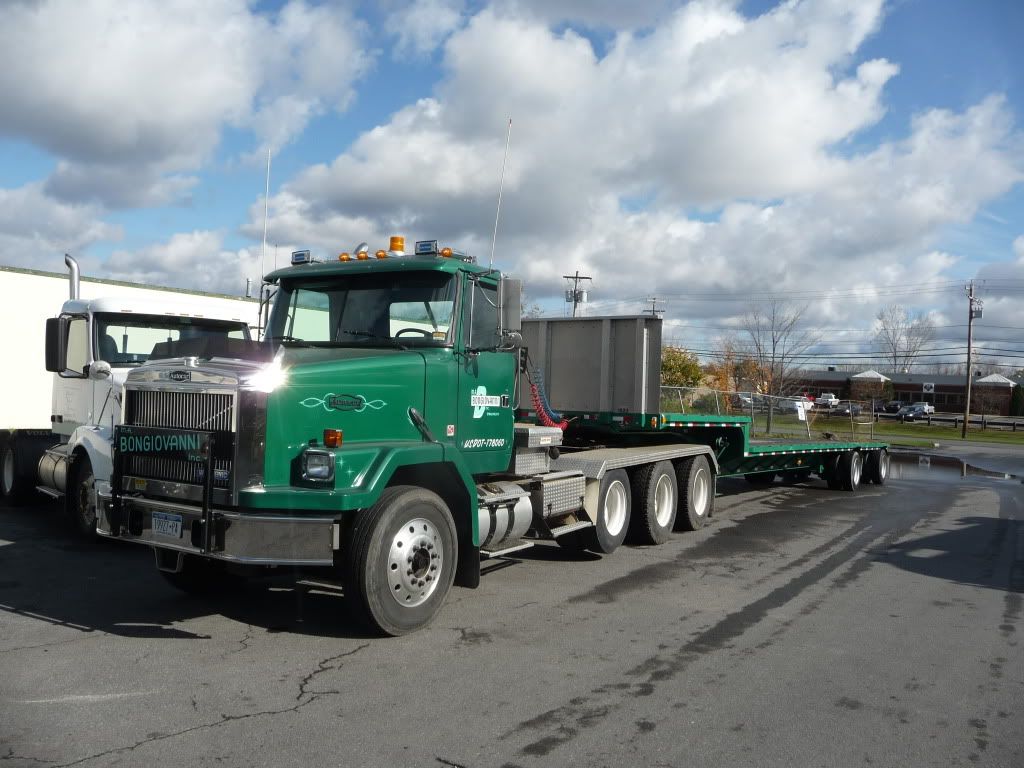Post by Muleskinner on Jul 9, 2013 12:30:55 GMT -8
Well I finally finished her. It took a lot of planning and a lot of parts from the parts box but here she is. I reworked the interior floor tub to get it up to par and used the ERTL cement mixer frame which had to be extended 6' at the tail to give the rig a stinger. Also had to cut of the forward section of the frame where the PTO unit for the mixer sat. I decided to opted for the standard Timber Bumper of the time and added a Spicer Secondary tranny to give it that twin stick 5-4 configuration which was prevalent on most Offers of the late Fifties and early sixties. The tires and wheels came from Ap40 for the rig and trailer as did the cab. The stack was made from a jointed drinking straw which looked more to the effect of the older style stacks which most of these rigs ran. The rig is also fitted out with water cooled brakes for both rig and trailer. It is heavily weathered to show the many years of use in the Hayfork area of California hauling Logs.
She is loaded up with three Bunker culls for load footing, Four fir and a Redwood topper complete with burl knot on the end. With the load she has a 14' over hang in the rear and is a total of 18' at the top, enough to scrape all the tattle tails hanging at the scales and to autograph the hill sides on the Down hill run with her tail. Most offers I ever seen loaded straight up when possible and if need be loaded straight out and up, which was very seldom, because of the twisting logging roads they had to traverse. The over hang also made it hard when passing another truck coming in on a curve, but being loaded you had the right of way and it was up to the one running light to back up and find a place to pull over and let the loaded pass.
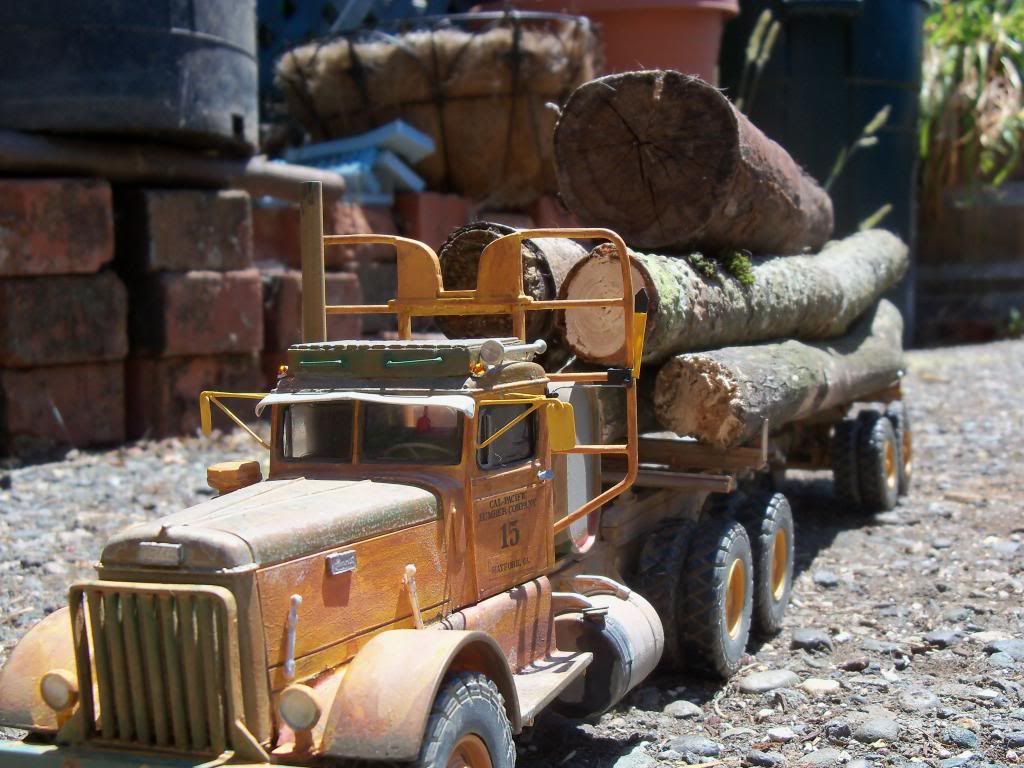
Eighteen feet at the top

Fourteen feet at the over hang.
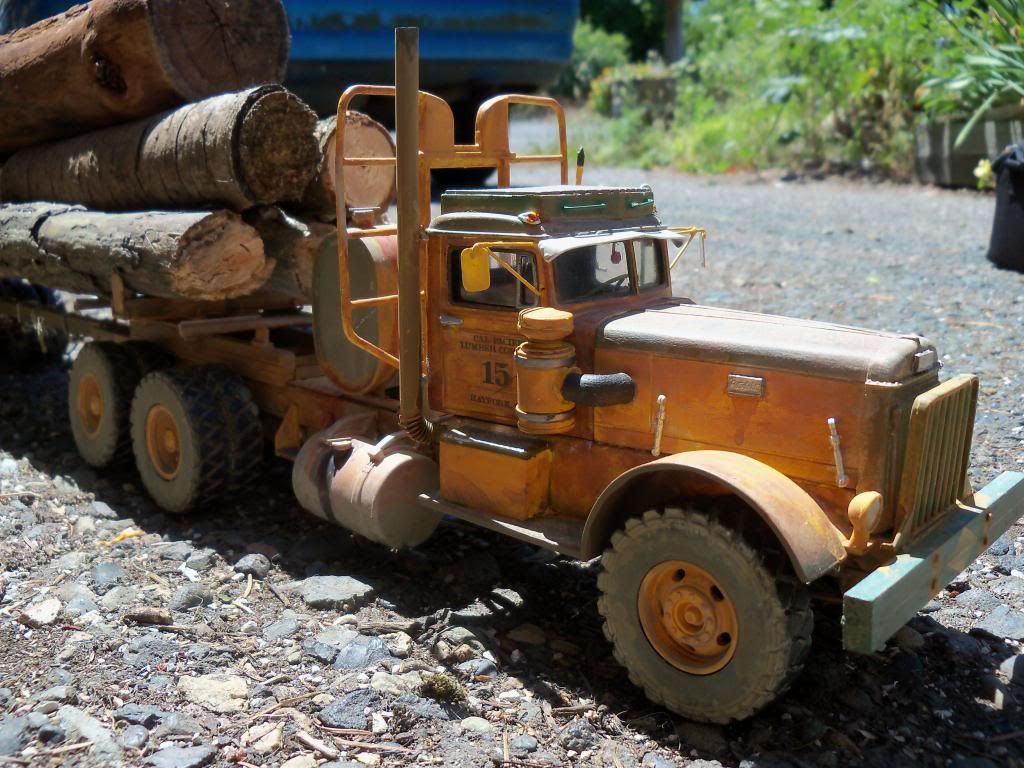
Detail shot: Curb side.
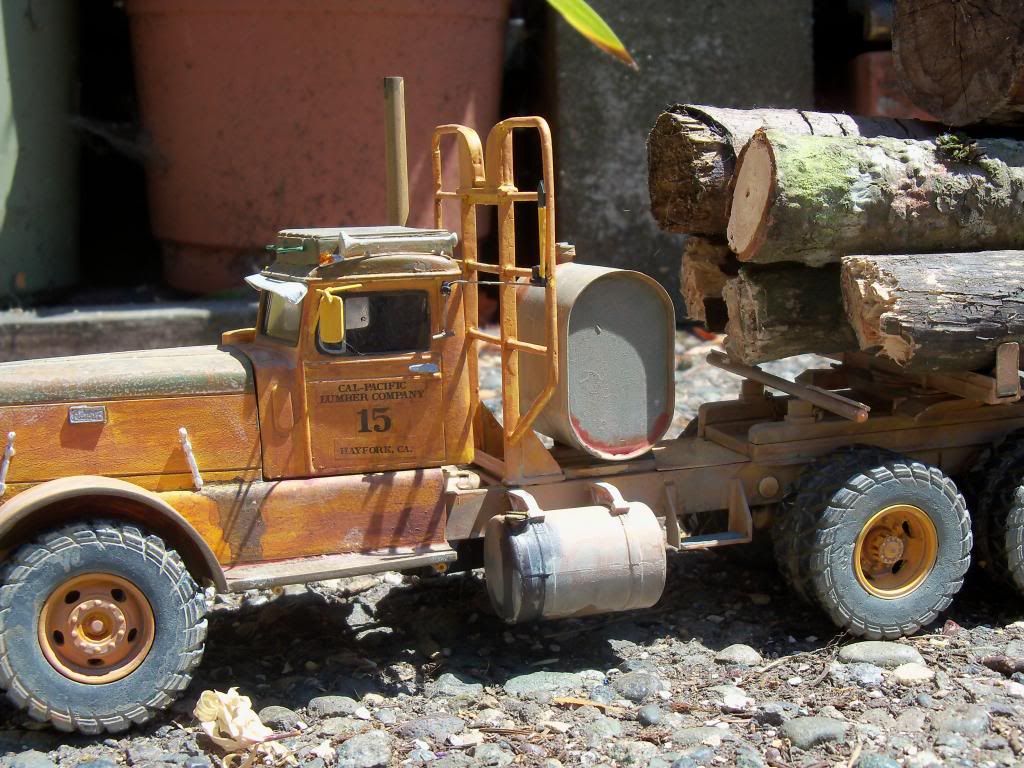
Detail shot: Drivers side

Detail shot: Head On
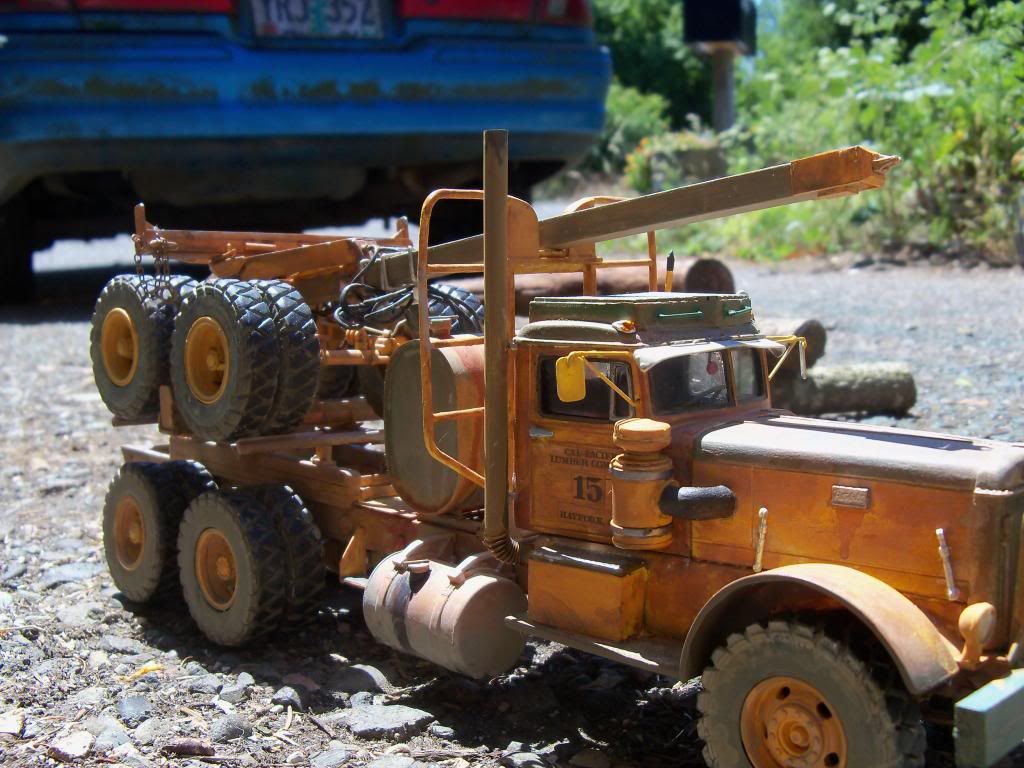
Detail shot: Running Light
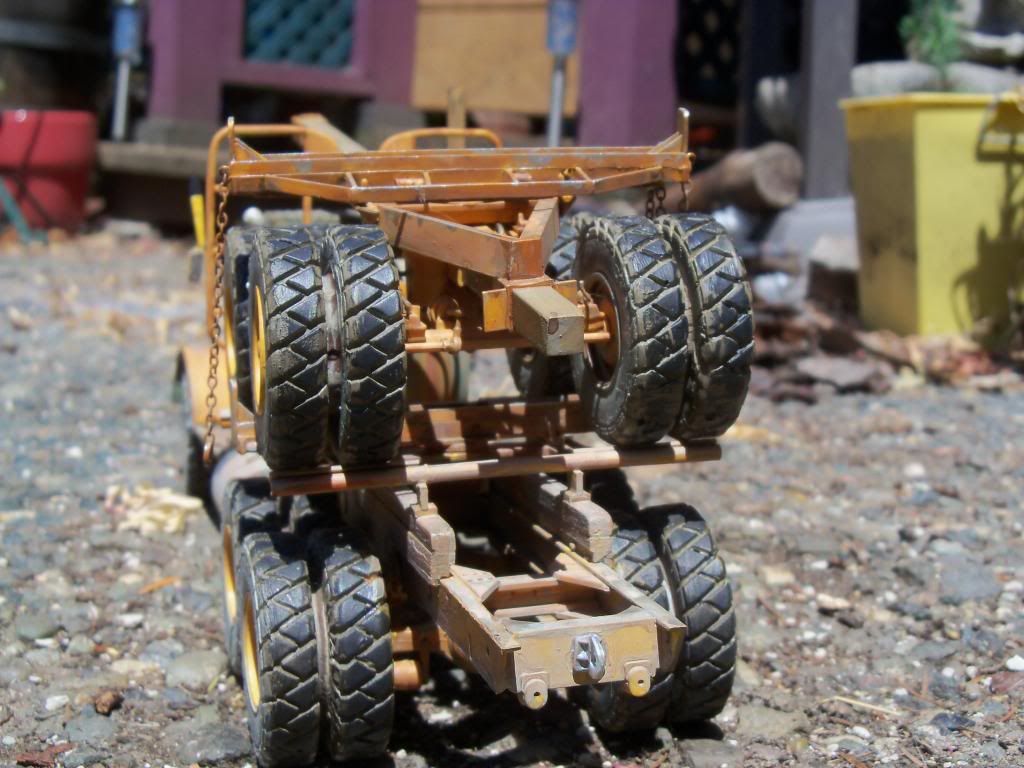
Running Light.
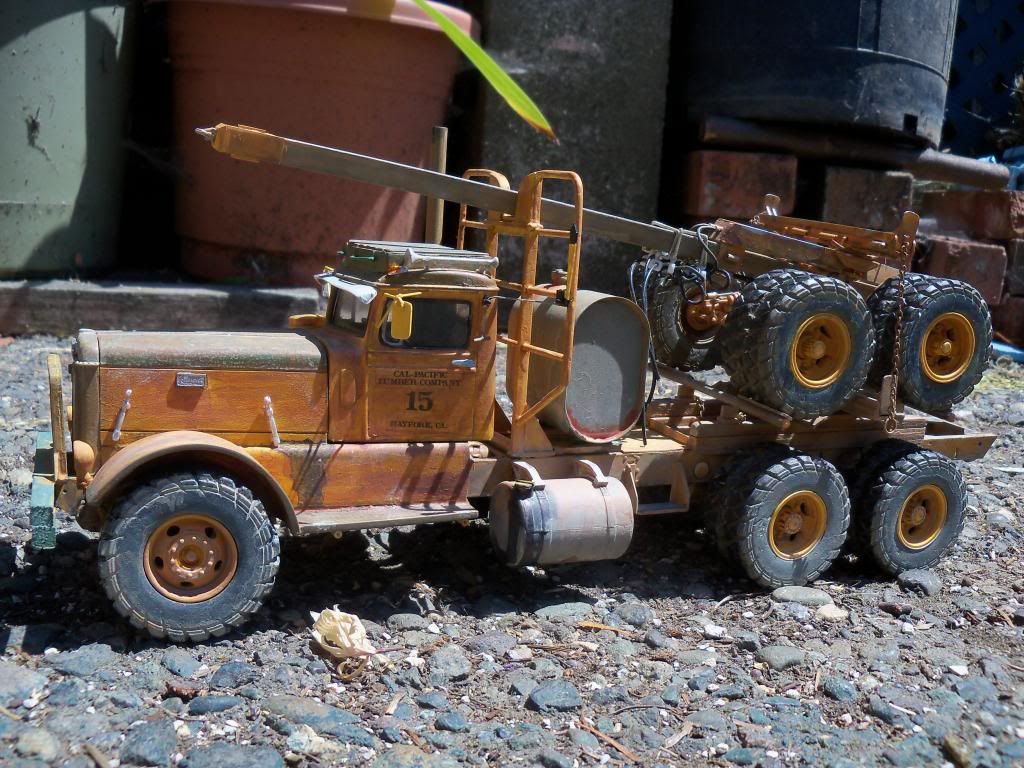
Drivers side view. Notice the Turn indicator Wg Wag on the head ache rack and the pull cord for the driver to operate it from the cab.
One note I must make here is the absence of the rear truck brakes which got knocked of when I moved it outside for photographing. With all the resin in the cab, wheels and tires, plus the metal of the cast headache rack it made for a bitch of a move and things do happen.
Now that this unit is done I can direct my attention to the Ketchikan Sterling which I will also be making into an Offer from Alaska.
All in all this project was involved a lot of research and planning before the rig started taking shape, but in the long run really paid off in the form of a nice looking representative of a rig which once plied the mountains of Hayfork, California for many years, back in the prehistoric days of logging.
One thing you will notice is the absence of tail lights on this rig. In the prehistoric days, most off hiway rigs spent their time on the dusty and little used back roads of the Pacific northwest and ran mostly during the day time hours. The drivers of these rigs were geared to following the terrain features of the roads and thus when one rig was following another, they stayed far back with a lot of space in between the rigs to be out of the dust zone. thus there was little need for the mandatory tail light laws we have now. each driver was well aware of the roads and would know at any given moment where he was and how close he was to the lead rig by the amount of dust he was encountering. In other words heavy dust poor visibility meant he was to close to the lead rig and it was time to back off. A little dust meant he was at a safe distance and could proceed. But the drivers always anticipated what was around the next curve in the road. Speed was not as important factor as safety and looking out for the other guy. I rode a couple of time in these rigs and my hat really goes off to the men who drove these monters with their heavy and sometimes very top heavy loads from the woods to the mill.
She is loaded up with three Bunker culls for load footing, Four fir and a Redwood topper complete with burl knot on the end. With the load she has a 14' over hang in the rear and is a total of 18' at the top, enough to scrape all the tattle tails hanging at the scales and to autograph the hill sides on the Down hill run with her tail. Most offers I ever seen loaded straight up when possible and if need be loaded straight out and up, which was very seldom, because of the twisting logging roads they had to traverse. The over hang also made it hard when passing another truck coming in on a curve, but being loaded you had the right of way and it was up to the one running light to back up and find a place to pull over and let the loaded pass.

Eighteen feet at the top

Fourteen feet at the over hang.

Detail shot: Curb side.

Detail shot: Drivers side

Detail shot: Head On

Detail shot: Running Light

Running Light.

Drivers side view. Notice the Turn indicator Wg Wag on the head ache rack and the pull cord for the driver to operate it from the cab.
One note I must make here is the absence of the rear truck brakes which got knocked of when I moved it outside for photographing. With all the resin in the cab, wheels and tires, plus the metal of the cast headache rack it made for a bitch of a move and things do happen.
Now that this unit is done I can direct my attention to the Ketchikan Sterling which I will also be making into an Offer from Alaska.
All in all this project was involved a lot of research and planning before the rig started taking shape, but in the long run really paid off in the form of a nice looking representative of a rig which once plied the mountains of Hayfork, California for many years, back in the prehistoric days of logging.
One thing you will notice is the absence of tail lights on this rig. In the prehistoric days, most off hiway rigs spent their time on the dusty and little used back roads of the Pacific northwest and ran mostly during the day time hours. The drivers of these rigs were geared to following the terrain features of the roads and thus when one rig was following another, they stayed far back with a lot of space in between the rigs to be out of the dust zone. thus there was little need for the mandatory tail light laws we have now. each driver was well aware of the roads and would know at any given moment where he was and how close he was to the lead rig by the amount of dust he was encountering. In other words heavy dust poor visibility meant he was to close to the lead rig and it was time to back off. A little dust meant he was at a safe distance and could proceed. But the drivers always anticipated what was around the next curve in the road. Speed was not as important factor as safety and looking out for the other guy. I rode a couple of time in these rigs and my hat really goes off to the men who drove these monters with their heavy and sometimes very top heavy loads from the woods to the mill.



